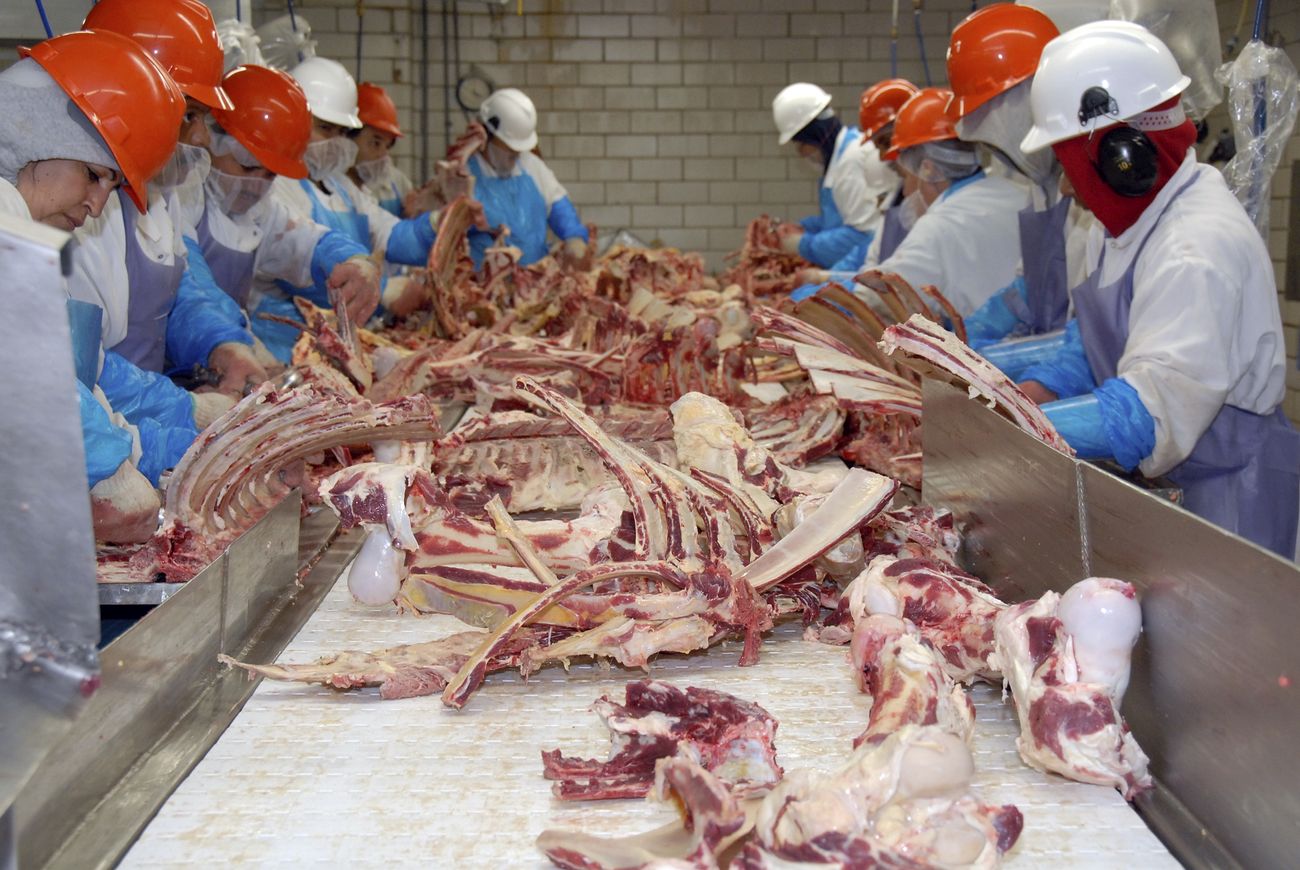The Psychological Impact of Animal Slaughter on Slaughterhouse Workers and the Spillover Effects in their Communities
Ryan Mahabir, Wake Forest University School of Law JD ’23
It’s a hot afternoon. The grill is fired up, ready to cook some hotdogs and hamburgers. As you enjoy the food, have you thought about the cows, pigs, and other animals who had their lives cut short to produce the very meal you are eating? Have you considered the slaughterhouse worker who had the arduous task of ending the animal’s life so that it could be processed into ground beef for the burger? That same slaughterhouse worker is tasked with killing animals eight hours a day so that you can enjoy a cookout. Every hour, “1,000,000 chickens, 14,000 pigs, and 4,000 cows are slaughtered for human consumption in the United States.” These workers perform a job that, by its very nature, puts them at risk of psychological disorders.
This commentary identifies the occupational hazards of slaughterhouse work, exploring how they create a uniquely stressful, dangerous, and violent environment. Specifically, this commentary analyzes how the routinized killing of animals affects slaughterhouse workers’ physical and mental state and the spillover public health effects on their families and their community, comparing incidences of serious psychological distress and alcohol abuse between slaughterhouse workers and non-slaughterhouse workers and domestic violence and violent and sexual crime in communities around slaughterhouses and in communities elsewhere. It concludes by proposing educational initiatives and reallocating government subsidies to incentivize a vegan lifestyle.
How the Sausage is Made: The Animal Agriculture Industry
In January 2021, commercial meat production for the United States alone totaled 4.80 billion pounds. The meatpacking industry, specifically the portion that involves the slaughter of animals, employs between 77,980 to 144,300 individuals. To supply such a daunting amount of meat with so few employees, workers are pushed to kill more animals in less time.
Just as the meat industry does not consider the mental health and physical well-being of the animals they exploit and slaughter, the industry has done little to protect the mental health of its employees. As a recent example, former President Trump’s executive order during the pandemic to keep slaughterhouses open despite COVID-19 outbreaks killing workers shows the meat industry treating their employees as replaceable cogs in a machine. This treatment is both dangerous to their health and detrimental to their mental and psychological well-being.
Slaughterhouse work is extremely dangerous, physically demanding, and pays very low wages. In fact, the average slaughterhouse worker makes only $25,010 per year, slightly above the poverty line for a family of four. Nearly half of all meatpacking workers live in low-income families, and about 12% earn income below the poverty line. This compares to 20.6% of all U.S. workers from low-income families and 6.7% of all workers with income below the poverty level. Meatpacking workers generally lack health insurance, have caretaker responsibilities, and are less educated, with only 2.5 % having a college degree.
Most workers are “at-will” employees, meaning they can be easily fired for any legal reason at a supervisor’s discretion, which discourages employees from reporting safety and other concerns in the workplace. Nearly one-half of meatpacking workers are Hispanic, and one-quarter are Black. Immigrants are particularly overrepresented in slaughterhouse work, as reflected by the fact that 17% of workers in the U.S. workforce today are immigrants, but 51.5% of meatpacking workers are immigrants. To make matters worse, a growing percentage of these workers are undocumented immigrants who are unable to voice their concerns for fear of deportation and being separated from their families.
These issues regarding mental health are compounded by the slaughterhouse work culture of suppressing emotions to avoid showing weakness. Repression of emotion is defined as the “intentional and automatic method by which individuals exert control over the emotions they have.” Effective emotional regulation helps people cope with stress, but taken to the extreme can also pose a danger to emotional and cognitive health, which in turn can factor into mental or physical disease conditions.
Slaughterhouse workers likely suppress their emotions to cope due to a combination of slaughterhouse work factors, like the stressful environment from the high rates of injury among the workers. Slaughter facilities boast nonfatal injury rates of up to twenty out of every hundred workers, making slaughterhouse work the most dangerous profession in the United States. The dangers come from repetitive motions, heavy lifting, and interacting with live, frightened, and dangerous animals that must be contained and controlled.
The workers in the most danger are “stickers” who slit the animals’ throats so they bleed out. While all non-poultry livestock must be stunned before being bled out, this aspirational goal is not always successful. Stunning is a precise science, and foremen often adjust the settings on knockers and electric shock guns for each animal to protect the quality of the meat. Line speeds are often excessively fast, leading to conscious, active animals often flying down the conveyor line toward stickers. The stickers then face the danger of being struck by the large, terrified animals while holding sharp knives, which puts stickers at great risk of injuries and vulnerable to serious psychological distress when combined with the kicking animals.
Unclean Hands: An Analysis of Slaughterhouse Worker Mental Trauma and the Resulting Spillover Effects
A. Serious Psychological Distress
Serious psychological distress (SPD) encompasses mental health problems severe enough to cause “moderate-to-serious impairment in social, occupational, or school functioning and to require treatment.” Several factors could lead to unnecessarily high levels of SPD among slaughterhouse workers. One study published by the Boston University School of Public Health studied the incidence of SPD amongst meatpacking workers and found a 4.4% incidence of SPD amongst the meatpacking workers compared to 3.6% amongst the general U.S. population. While this isn’t a statistically significant difference, the results should still raise some alarm given the small sample size of 137 volunteer participants of about 2,000 meatpacking workers from a single beef slaughter and processing facility in Nebraska. If nothing else, the results suggest that there is a need for more research into slaughterhouse workers’ mental health.
The speed at which workers must operate, which can be as quick as 360 heads per hour in U.S. beef packing plants, has been identified as a cause of anxiety among workers. Additionally, the combination of long hours and repetitive motion directly leads to an increased risk of injury. Repetitive stress injuries are unavoidable under the frantic pace that most facilities choose to operate. According to a 2000 OSHA report, “one out of every seven poultry workers was injured on the job,” more than double the average for all private industries. Poultry workers were also found to be “14 times more likely to suffer debilitating injuries stemming from repetitive trauma.” Other hazards slaughterhouse workers face may face include noise exposure, dangerous equipment and work settings, and exposure to biological agents and chemicals.
B. Perpetration-Induced Traumatic Stress
A combination of these difficult working conditions and the repetitive trauma of routinely killing animals contributes to psychological disorders, specifically a type of post-traumatic stress disorder called perpetration-induced traumatic stress (PITS), which encompasses symptoms of drug and alcohol abuse, panic, depression, paranoia, dissociation, anxiety, and depression stemming from the act of killing. Unlike the more well-known PTSD, in which sufferers have been victims of a traumatic situation. The stress from PITS is a manifestation of guilt for being the direct reason for another being’s trauma. While few studies have been conducted, symptoms of PITS, like alcoholism, comport with slaughterhouse workers’ testimonies about their experiences.
- Alcohol Abuse
Alcohol use disorder (AUD) is a medical condition characterized by an “impaired ability to stop or control alcohol use despite adverse social, occupational, or health consequences.” Mental health conditions and a history of trauma are significant risk factors for developing AUD.
Slaughterhouse workers were found to have increased alcohol consumption during weekdays and weekends compared to other occupations. Alcohol is very common amongst slaughter employees as a coping mechanism for the stress of their work. A former hog-sticker echoed this fact; stating, “[a] lot of the slaughterhouse hog killers have problems with alcohol. They have to drink, they have no other way of dealing with killing live, kicking animals all day long.”
Another study proposed a link between slaughterhouse violence and alcoholism. Researchers found that empathy for pain tends to happen “even when the pain is being experienced by others who are different than oneself.” The researchers posited that animal suffering triggers an empathetic response in slaughterhouse workers. Alcohol becomes a coping mechanism to deal with the empathetic suffering and disassociate from the daily pain.
- Greener Pastures: Solution to End Slaughterhouse Suffering
First and foremost, there must be a push for more research on slaughterhouse worker mental health. More published research will likely draw more media attention, but in the short term, legislation should be passed to regulate and reduce line speeds for worker safety and increase the number of OSHA inspectors in slaughterhouses to enforce these regulations.
In the long term, the solution is to reduce consumer demand for meat and the financial viability of meat production. A two-prong solution combining consumer market influence with government economic policy would likely achieve both parts of the solution. The first prong involves disincentivizing the production and consumption of animal products by transferring federal meat industry subsidies. Currently, the U.S. government spends up to $38 billion each year to subsidize the meat and dairy industries, with less than one percent of that sum allocated to aiding the production of fruits and vegetables. The large subsidies allow meat prices to remain relatively low even though meat production is a costly and inefficient process. For example, without these subsidies, hamburger meat would cost $35 a pound, with the current cost of ground beef being $4-5 per pound. These meat and dairy subsidies could be transferred to plant agriculture to increase plant-based food production. Although no country has attempted this subsidy transfer, a 2021 United Nations report called for a subsidy-shifting scheme by “[r]epurposing agricultural support to shift our agri-food systems in a greener, more sustainable direction — including by rewarding good practices such as sustainable farming and climate-smart approaches.” Additionally, the federal government could offer tax credits for businesses selling vegan products.
The second prong will introduce consumers to a vegan lifestyle through a national public education campaign. The campaign would use television, social media, and YouTube to both explain and advocate veganism, which is a way of living that “seeks to exclude–as far as possible and practicable–all forms of exploitation, of and cruelty to, animals for food, clothing and any other purpose.”
Conclusion
As exploitative and detrimental as the meat industry is, it only exists because of the demand for animal-based products. The number of vegans is growing in the U.S. exponentially—in fact, between 2014 and 2017, the number of consumers identifying as vegan increased by 600%. People are starting to recognize that the best thing they can do is adopt a vegan lifestyle that excludes, as much as practicable, any animal products, including food, clothing, and cosmetics.
Envision yourself again at the cookout. The grill is fired up, but it’s cooking veggie skewers, and plant-based hotdogs and burgers. You’re respecting the slaughterhouse workers by refusing to support the system that harms and exploits them. This time I bet you’ll enjoy the food just as much, if not more. By changing our habits, we can break this cycle of exploitation and suffering of both animals and human beings.
**This article was shortened to meet publication guidelines. The full version of this text can be downloaded below.

